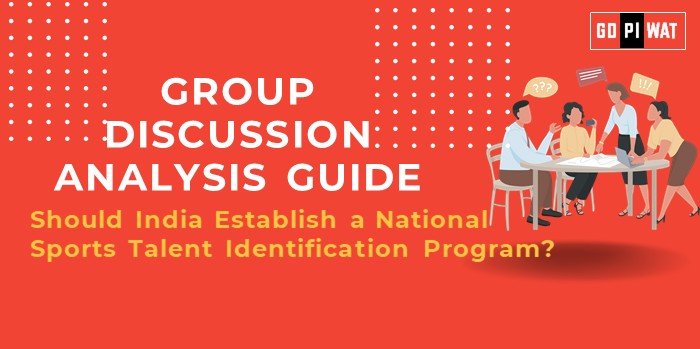📋 Group Discussion (GD) Analysis Guide
Should India Establish a National Sports Talent Identification Program?
🌐 Introduction to the Topic
- Opening Context: “Sports excellence is a key indicator of a nation’s global competitiveness and cultural vitality. Establishing a National Sports Talent Identification Program could redefine India’s sporting future.”
- Background: Countries like China, the USA, and Australia have implemented systematic talent scouting and nurturing mechanisms with proven success. India, despite its demographic advantage, faces challenges like underutilized talent and inadequate infrastructure.
📊 Quick Facts and Key Statistics
- India’s Youth Population: Over 365 million people aged 10-24, showcasing untapped potential.
- Olympic Performance (2021): 7 medals, highest ever, but still lagging behind nations like the USA (113 medals).
- Sports Budget Allocation (2023): ₹3,397 crore, a marginal increase of 11% from 2022.
- School Sports Penetration: Only 30% of schools have access to adequate sports infrastructure (Ministry of Education, 2023).
👥 Stakeholders and Their Roles
- Government Agencies: Policy formulation, funding, and infrastructure development.
- Sports Federations: Training and identifying talent across states.
- Educational Institutions: Grassroots scouting and skill development.
- Private Sector & NGOs: Sponsorships, coaching programs, and infrastructure development.
- Athletes & Parents: Active participation and cultural support for sports careers.
🎯 Achievements and Challenges
Achievements:
- Khelo India Initiative: Identified over 2,000 athletes under its Talent Development Scheme.
- Olympic Medal Surge: Improved performance in Tokyo 2021 due to targeted support.
- Emerging Sports Infrastructure: Increased funding for academies and training centers.
Challenges:
- Lack of structured scouting mechanisms leading to talent waste.
- Socio-economic barriers hindering rural participation.
- Limited budget allocation compared to global benchmarks (China spends $2 billion annually on sports).
- Infrastructure gaps, especially in Tier-2 and Tier-3 cities.
🌍 Global Comparisons
- China: “Olympic Glory Program” identifies and trains athletes from a young age.
- Australia: AIS (Australian Institute of Sport) revolutionized national sports through focused training.
📚 Case Study
Haryana’s sports policy has yielded Olympic stars like Neeraj Chopra, owing to local talent scouting and development.
💬 Structured Arguments for Discussion
- Supporting Stance: “A national program can systematically identify talent, enhancing India’s global sports standing.”
- Opposing Stance: “Given limited resources, India should focus on grassroots development before implementing a national program.”
- Balanced Perspective: “A phased approach starting with priority sports and regions could yield better outcomes.”
✨ Effective Discussion Approaches
- Opening Approaches:
- Data-Driven Start: “India’s 365 million youth population presents immense potential for sports if harnessed effectively.”
- Case Study Opening: “The success of Haryana’s sports initiatives shows how targeted talent scouting transforms potential into performance.”
- Global Comparison: “China’s systematic talent identification program brought 88 Olympic medals in 2021, showcasing the value of national-level planning.”
- Counter-Argument Handling:
- “Budget constraints can be mitigated through public-private partnerships.”
- “Socio-cultural barriers can be addressed through community-level awareness campaigns.”
🛠️ Strategic Analysis of Strengths and Weaknesses
- Strengths: Large youth population, government support through schemes like Khelo India.
- Weaknesses: Uneven infrastructure, lack of trained scouts, limited funding.
- Opportunities: Global sponsorships, technology-enabled scouting, increased societal interest in sports.
- Threats: Corruption in sports federations, socio-economic disparities.
📌 Connecting with B-School Applications
- Real-World Applications: Lessons in resource allocation, leadership, and impact assessment in management.
- Sample Interview Questions:
- “How can India replicate China’s success in sports?”
- “What role do public-private partnerships play in sports development?”
- Insights for Students: Analyze ROI in large-scale projects, explore sponsorship-based funding models.


